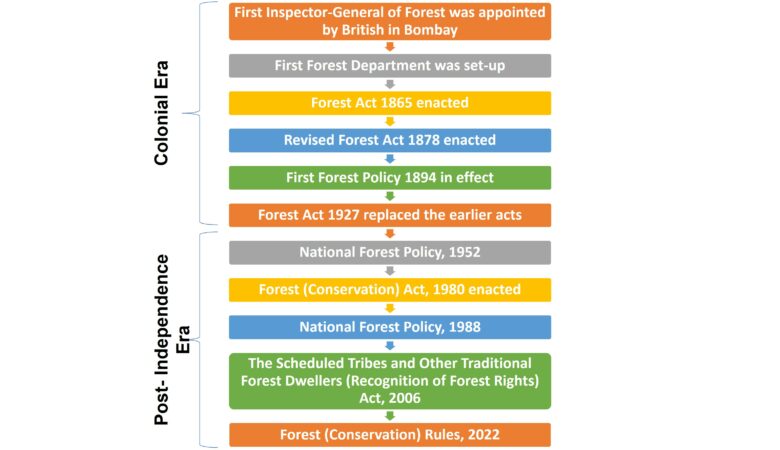Introduction
Forests are an important component of the environment and are beneficial for the quality of life it provides. In India, it was during the British Government that they considered it imperative to have forest laws that govern and safeguard the forest and its resources in the country. The Inspector-General of Forests was first appointed in India, who realized that a proper system had to be introduced to manage the forests and train people in the science of conservation. This required rules for the forest and its resources. Hence, the Indian Forest Service was set up in 1864 that worked on the formulation of the Indian Forest Act of 1865. The Act was amended twice, each in 1878 and 1927.
In 1894, the British Indian government created its first forest policy, referred to as the National Forest Policy. The policy focused on giving the state control of forests and using them to generate revenue for the government. All of the management plans, ideas from scientific management, and institutions like the forest department were aimed at increasing revenue for the British Empire.
During British rule, the Empire was not concerned with the people living in the forest, their livelihoods, or protecting forests and wildlife. Instead, a forest department was established and a catalogue of trees took place. Customary rights were limited as concessions were given out to individuals at the discretion of the forestry officials. Furthermore, forests became a considerable source of income for the government.
Historical Timeline
Figure 1: Timeline of the key policies of Indian forests

- British authorities appointed the first Inspector-General of Forests in 1850, and established the first Forest Department in 1864.
- The Forest Act of 1865 was established, which classified the forests into reserved forests and unclassified forests, to generate more income.
- In 1878, the Forest Act took away communal rights to forests and replaced them with privileges, which had to be paid for.
- In 1894, the first Forest Policy was established, with a focus on agriculture rather than forests.
- In 1927, the Forest Act was revised, making the regulations stricter and reducing people’s rights even more.
- During the adoption of the Forest Policy of 1952, large swaths of forest land from princely states and “zamindaris” were taken. The policy recommended 33% of all land in India to be covered by forests or trees. It outlined comprehensive instructions for managing and preserving forests and wildlife.
- The Forest Conservation Act was enacted in 1980 to protect and conserve the country’s forests.
- The National Forest Policy of 1988 was enacted to revise the previous National Forest Policy of 1952.
- The Scheduled Tribes and Other Traditional Forest Dwellers (Recognition of Forest Rights) Act was passed in 2006 to address the historical injustice done to forest dwellers.
1. Indian Forest Act (1865, 1878, and 1927)
The Indian Forest Act was implemented by the British in order to regulate the local use of forests. It was a landmark legislation that gave the State power to control the rights to use forests and regulate the use of timber and other forest produce. It also aimed to levy taxes on timber and other forest produce, which became a source of revenue for the government. The Indian Forest Act of 1927 was enacted to improve the previous Indian forest laws implemented under the British and make them more effective.
Types of Forest Land under the Indian Forest Act
The Indian Forest Act classified the forests into three types – reserved forests, protected forests and village forests. The Act allowed the government to demarcate reserved and protected forests. Local rights were denied in regard to protected forests, while certain privileges given to locals by the government were subject to revocation. This policy sought to manage the gathering of resources from forests by forest dwellers. Breaching this policy was considered an offence, resulting in imprisonment and fines, allowing the government to assert their authority over forests.
Reserved Forest
Reserved Forests are the most restricted forests and are declared by the Government for the conservation of forests and wildlife resources. Activities like hunting and cutting trees are strictly prohibited in these forests, unless there is a valid reason and permission from higher authorities. Reserve forests are covered under Chapter 2 of the Indian Forest Act 1927, which gives the government proprietary rights over them and local people cannot use them without permission.
Some examples of Reserved Forests in India include Hanumasagara Reserve Forest (Karnataka), Begur Reserve Forest (Kerala), Attappadi Reserve Forest (Kerala) and Sholayar Reserve Forest ( Tamil Nadu).
Protected Forest
Protected Forests are those forests which are declared by the Government for the purpose of conservation and protection. These forests are not reserved under the state government, but instead have proprietary rights held by the government. The State Government has the power to make rules and restrictions on the use of these forests, as well as reserve certain species of trees for revenue-raising purposes. These forests are managed by the forest department and local people can use them with permission from higher authorities. Activities like hunting and cutting trees are strictly.
Village Forests
Village forests are ones that the State Government grants rights of ownership over to certain village communities with land that has been designated as a reserved forest. It provides an opportunity for local communities to manage their own resources in a sustainable manner. Section 28 of the Indian Forest Act deals with the provisions of village forests and outlines how they can be established and managed.
The State Government can give rights to any village group over land that has been reserved for this purpose, with rules for regulating its management also set by the State Government. The establishment of village forests provides an opportunity for local communities to manage their own resources in a sustainable manner.
Figure 2: Tree Harvesting in a forest in Kerala, India

2. Forest Conservation Act, 1980
The Forest (Conservation) Ordinance, 1980 was enforced by the President of India to conserve forests, which was later repealed by the Forest (Conservation) Act, 1980. For centuries, people living in and around forests have had a symbiotic relationship with their environment. However, during colonial times this relationship shifted from local communities using forests as a resource to State resources for commercial interests. Further, with the increasing human population, forests were being depleted at an alarming rate. These led to the enactment of the Forest Conservation Act, 1980 which ensures their protection and sustainable use.
Features of the Forest Conservation Act 1980
The Forest Conservation Act of 1980 superseded the Indian Forest Act of 1927, which was geared toward protecting the commercial interests of the British Empire in India. The law extends to the whole of India and was amended in 1988. It seeks to protect forests and ensure their sustainable use by restricting the use of forests for non-forest purposes. The Act not only prevents deforestation but also ensures that any changes made to existing forests are done so responsibly and with due consideration for the environment.
The Act also restricts the state government and other authorities from taking decisions without permission from the Central government, and levies penalties in case of violations of its provisions. This act has been instrumental in protecting India’s forests and their associated wildlife for decades now, making it one of the most important pieces of environmental legislation in India today.
3. National Forest Policy
The National Forest Policy was first enacted in 1952. In 1988, the policy was revised by the Parliament of India to revise the previously enacted policy of 1952. The main objective of this policy was to ensure that the management of forests is undertaken in a sustainable manner and that local/tribal communities are empowered and involved in their protection and development. One of the direct outcomes of this policy was the establishment of Joint Forest Management (JFM). This policy aimed at maintaining environmental stability, recovering ecological balance, protecting natural heritage with flora and fauna, preventing soil erosion, floods and drought as well as increasing forest cover through afforestation programs.
The National Forest Policy also sought to promote efficient utilization of forest resources for meeting basic human needs such as fuelwood, fodder, and small timber while ensuring that these activities do not lead to deforestation or degradation. It also emphasized the need for the conservation of biological diversity by protecting endangered species and preserving genetic diversity. Furthermore, it suggested measures for improving productivity through scientific management practices such as silviculture, agroforestry.
New national forest policy pending
The new National Forest Policy has been in the works for nearly four years, but a final version is yet to be made public. In June 2016, the environment ministry had announced a draft NFP. However, due to criticism regarding its ability to protect existing forest regulations, the ministry later withdrew it and insisted it was only a “study”. Later in 2018, the government released the draft of the National Forest Policy. In 2019, the draft was updated, but there has been no information regarding the finalized NFP since then.
The policy provides an overarching framework and direction for the management and regulation of forests in the country. The new policy is also an important step toward addressing the challenge of climate change in India and aims to bring a minimum of one-third of India’s total geographical area under forest cover through scientific interventions and enforcing strict rules to protect the dense cover. However, experts disagree with the government’s assertion that the draft of the new national forest policy is focused on protecting the interests of forest dwellers and tribal people. Some also believe that the National Forest Policy, 1988 has several problems and that the new draft policy could be more problematic.
4. Scheduled Tribes and Other Traditional Forest Dwellers (Recognition of Forest Rights) Act, 2006
Figure 3: Children from a tribal community of Nagaland, India

The Scheduled Tribes and Other Traditional Forest Dwellers (Recognition of Forest Rights) Act, 2006 was passed to address the historical injustice done to forest dwellers. This law was designed to strike a balance between their right to the environment and their right to life and livelihood. The Indian Forest Act of 1927 provided for the settlement of rights but was rarely implemented. The National Forest Policy of 1988 recognized the symbiotic link between forests and forest-dwelling inhabitants, which led to the enactment of this law.
The Act recognizes the rights of forest-dwelling tribal communities and other traditional forest dwellers to access and use traditional forest resources. It also provides rights to self-cultivation, habitation, grazing, fishing, access to water bodies, habitat rights for particularly vulnerable tribal groups (PVTGs), traditional seasonal resource access of nomadic and pastoral communities, etc. It also enjoins upon the Gram Sabha the responsibility of conservation and protection of biodiversity, wildlife, forests and other ecologically sensitive areas.
The Act safeguards forest dwellers from unlawful evictions and provides basic development facilities such as education, health, nutrition, infrastructure etc. The law has been subject to considerable controversy in India with opponents claiming it will lead to massive destruction of forests. However, it is important that these rights are recognized in order for justice to be served for those who have been historically wronged.
5. Forest Conservation Rules, 2022
The Forest Conservation Rules 2022 are a set of regulations established by the Ministry of Environment, Forest and Climate Change (MoEFCC) to ensure that forest conservation is properly managed. The rules provide for the formation of an Advisory Committee and a Project Screening Committee in each state/UT to advise or recommend on matters related to forest conservation. The committees have been given specific timelines for reviewing non-mining projects between 5-40 hectares and mining projects within 75 days. For larger projects, the committee gets more time to review.
The rules also allow private developers to clear forests without first seeking permission from the forest dwellers, as well as permit the clearance of a forest without informing its authentic residents. To ensure that tribal rights are not violated, state governments have been given the responsibility of protecting Scheduled Tribes’ traditional forestlands. Furthermore, applicants for diverting forest land in hilly or mountainous states with green cover covering more than two-thirds of its geographical area, or in a state/UT with forest cover covering more than one-third of its geographical area, can take up compensatory afforestation in other states.
Why is Forest Conservation Rules 2022 being criticized?
The Forest Conservation Rules 2022 have been met with several criticism from environmental activists and forest dwellers alike. The rules shift the responsibility of taking the consent of forest dwellers before the approval of a project onto the state governments, allowing private developers to cut down forests without consulting the forest dwellers. Furthermore, the Union Government now has the right to permit the clearance of a forest without informing its authentic residents. This contradicts the Scheduled Tribes and Other Traditional Forest Dwellers (Recognition of Forest Rights) Act, 2006, which requires governments to seek free, prior, and informed consent of forest dwellers before allowing a project on their traditional lands.
The Forest Conservation Act 1980 was amended in 1988, extending it to cover the whole country. This means that all forests in India are now subject to these new rules which allow private developers to clear them without consulting those who live there or depend on them for their livelihoods. This has caused outrage amongst those who rely on these forests for their livelihoods, as they are being left with no option but to accept it. This is seen as an attack on indigenous rights and is causing much distress amongst those affected by it.
Roma Malik, a leading figure in the All India Union of Forest Working People, has expressed concern that the new rules will compromise communities’ say in deciding development projects. It has also received criticism from former Union environment minister, Jairam Ramesh, who claims that these new rules will end the ‘ease of living’ for the vast many, as once forest clearance is granted, no claims will be recognized and settled. He claims that these new rules will end the ‘ease of living’ for the vast many, as once forest clearance is granted, no claims will be recognized and settled. This could potentially have a negative impact on those who rely on forests for their livelihoods.
Read more related articles:
- Forest Management Planning (FMP)
- Environmental Laws & Protection Acts in India
- Joint Forest Management in India
- Ecosystem Services and Well Being: An example of Mangroves
- Unlocking the potential of cloud GIS in Forestry using new EOS Platform


